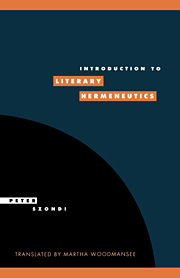Book contents
- Frontmatter
- Contents
- Foreword by Joel Weinsheimer
- Translator's preface
- Chapter 1 Introduction
- Chapter 2 Chladenius, I
- Chapter 3 Chladenius, II
- Chapter 4 Chladenius, III
- Chapter 5 Chladenius, IV
- Chapter 6 Meier, I
- Chapter 7 Meier, II
- Chapter 8 Ast
- Chapter 9 Schleiermacher, I
- Chapter 10 Schleiermacher, II
- Afterword by Jean Bollack
- Index
Chapter 10 - Schleiermacher, II
Published online by Cambridge University Press: 14 December 2009
- Frontmatter
- Contents
- Foreword by Joel Weinsheimer
- Translator's preface
- Chapter 1 Introduction
- Chapter 2 Chladenius, I
- Chapter 3 Chladenius, II
- Chapter 4 Chladenius, III
- Chapter 5 Chladenius, IV
- Chapter 6 Meier, I
- Chapter 7 Meier, II
- Chapter 8 Ast
- Chapter 9 Schleiermacher, I
- Chapter 10 Schleiermacher, II
- Afterword by Jean Bollack
- Index
Summary
Schleiermacher's theory of the two kinds of interpretation, the grammatical and the technical or psychological, follows from his thesis that understanding is composed of two moments: the understanding of speech as taken from language and the understanding of speech as a fact in the thinking subject. Each person, says Schleiermacher, is
on the one hand a locus where a given language takes shape in a particular way, and his speech can be understood only in the context of the totality of the language. But then he is also a constantly developing spirit, and his speech is only one fact in this development in relation to many others.
(p. 98)Understanding for Schleiermacher thus is not identical with recourse to authorial intention, as it was for Enlightenment hermeneutics. The speech (or writing) that is to be understood is not merely a sign or vehicle of an intended meaning. It does not disappear in the act of understanding in order to yield to what it signifies, the pure intention of the author. In opposition to both Enlightenment hermeneutics and the hermeneutics of the patristic-Scholastic tradition, it is speech or writing itself, the linguistic concretion, that is the object of interpretation and not the meaning, the sensus or the various sensus, of a passage. The boundary thus collapses that had separated hermeneutics from rhetoric and poetics in the earlier models; understanding the meaning meshes with interpretation in its current usage.
- Type
- Chapter
- Information
- Introduction to Literary Hermeneutics , pp. 121 - 134Publisher: Cambridge University PressPrint publication year: 1995

